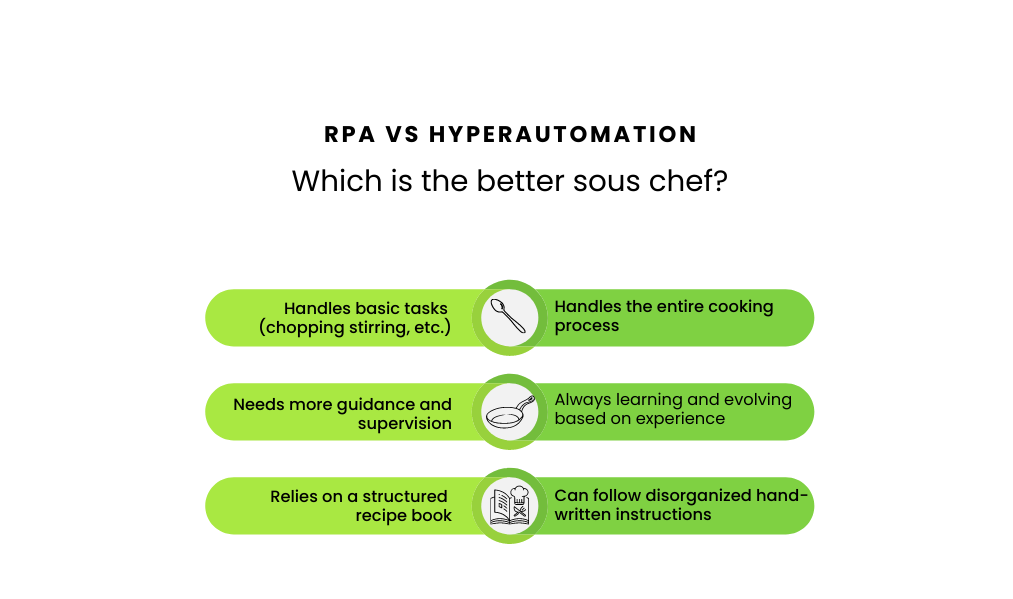Imagine: You’re working in a kitchen, cooking an exquisite meal, and you have two options for assistance. You must choose between a robotic assistant and an advanced human sous chef. The robot can follow predefined tasks, while the human assistant can adapt and adjust to your preferences. In this case, robotic process automation (RPA) is your robotic assistant, and hyperautomation is your human sous chef.
Analogies aside, how different are these two automation solutions? In this article, we’ll cover the following:
- Definition of robotic process automation (RPA)
- The role of intelligent automation
- Definition of hyperautomation
- The differences between RPA and hyperautomation
- The benefits of hyperautomation
- How to implement hyperautomation
Defining Robotics Process Automation
According to Gartner, “Robotics Process Automation is a noninvasive integration technology used to automate routine, repetitive, and predictable tasks through orchestrated UI interactions that emulate human actions.” There are also two distinct classes of RPA: Assisted and unassisted.
- Assisted: Bots are deployed on each desktop portal where the human worker executes specific activities while the bot performs the more complex and repetitive aspects.
- Unassisted: A managed and centralized server deployed bots via scheduling for automating workflows.

Back in the kitchen, RPA can handle repetitive and mundane tasks efficiently. Just like a robotic chef, RPA performs tasks exactly as programmed. It can chop vegetables, stir ingredients, and even handle basic cooking processes, saving you time and effort. Now that RPA is handling the smaller tasks and processes, you have more time to work on more complex culinary endeavors.
How does Intelligent Automation (IA) play a role?
RPA is designed to manage and automate rule-based and repetitive processes. Then, IA increases the technological capacity by adding artificial intelligence, machine learning, natural language processing, intelligent document processing, and structured data interaction. AI mimics human intelligence; therefore, it can incorporate analysis, reasoning, judgment, and decision-making.
What is hyperautomation?
Hyperautomation is like having an advanced cooking assistant who not only knows the basics but also understands your preferences, adjusts recipes on the fly, and proactively manages the entire cooking process.
You can defer to the human assistant with more complex tasks, like your recipe collection, dietary restrictions, and ingredient preferences. It not only automates the repetitive tasks but also actively searches for new recipes, suggests ingredient substitutions based on availability, adjusts cooking times based on the number of guests and even learns from your feedback to continually improve its performance. Hyperautomation is a comprehensive and intelligent system that orchestrates multiple automated processes to create a seamless and personalized cooking experience.
More literally, hyperautomation refers to the use of advanced technologies, like artificial intelligence (AI), machine learning (ML), and robotic process automation (RPA), to automate tasks that were once completed by humans.
Hyperautomation incorporates a variety of tools, including robotic process automation (RPA), intelligent process automation (IPA), intelligent business process management suites (iBPMS), iPaaS, and decision management systems. Hyperautomation is the ultimate automation toolbox- it can use AI to fine-tune cognitive functioning to surpass basic task automation to intelligent orchestration, which then induces adaptive decision-making, predictive insights, and guided recommendations. The only question is where to start extending your current automation technology footprint with hyper-automation.
What’s the main difference between hyper-automation and RPA?
Cross-functional collaboration. Before RPA, complex coding was required to drive automation. Today, RPA has simplified execution with robots. However, RPA is restricted to the automation of predefined and repetitive tasks. To institute hyperautomation, cross-functional collaboration is necessary. Hyperautomation takes RPA to the next level by facilitating intelligent and adaptive processes that recommend the next course of action instead of executing the same activities until told to stop.
In fact, hyperautomation breaks through inter-functional boundaries. Instead of RPA repeating the same monotonous activities, hyperautomation uses intelligence to decide the best strategy for performing those activities.
How does hyper-automation feel?
Hyper-automation provides digital workers who are interactive and responsive. Human workers can ask these digital workers questions as well, such as “Where may I access that critical report?” Hyper-automation creates an environment where human workers can find what they need to improve productivity and efficiency.
Interaction uses natural language processing that can respond to complex and long-form questions, for instance, “Would you find out which customer service agent worked on the highest number of tickets for Client A23GB684 in 2020? Next, would you ask the sales department at what percentage did they meet their 2020 quota?” This type of question requires a more profound understanding than merely asking what time is the next conference call. Sometimes your waiter can give you a more informed answer than your POS system.
Implement hyperautomation
If your company already utilizes RPA, then hyperautomation is the next step in the automation journey. You don’t have to change the recipe, but you should evolve and refine your technique. Why mix the batter with a spoon when you can use a mixer? Now you have more time to prepare entrees and create new recipes.
It’s crucial to consider whether a hyperautomation platform can support all the components you desire for driving end-to-end automation. With that being said, not all automation software will be the right fit for your company, including us. Nonetheless, we want to help you find the best solution for your organization’s processes so you can work smarter, not harder. Our team is on standby and ready to transform the way you work.






